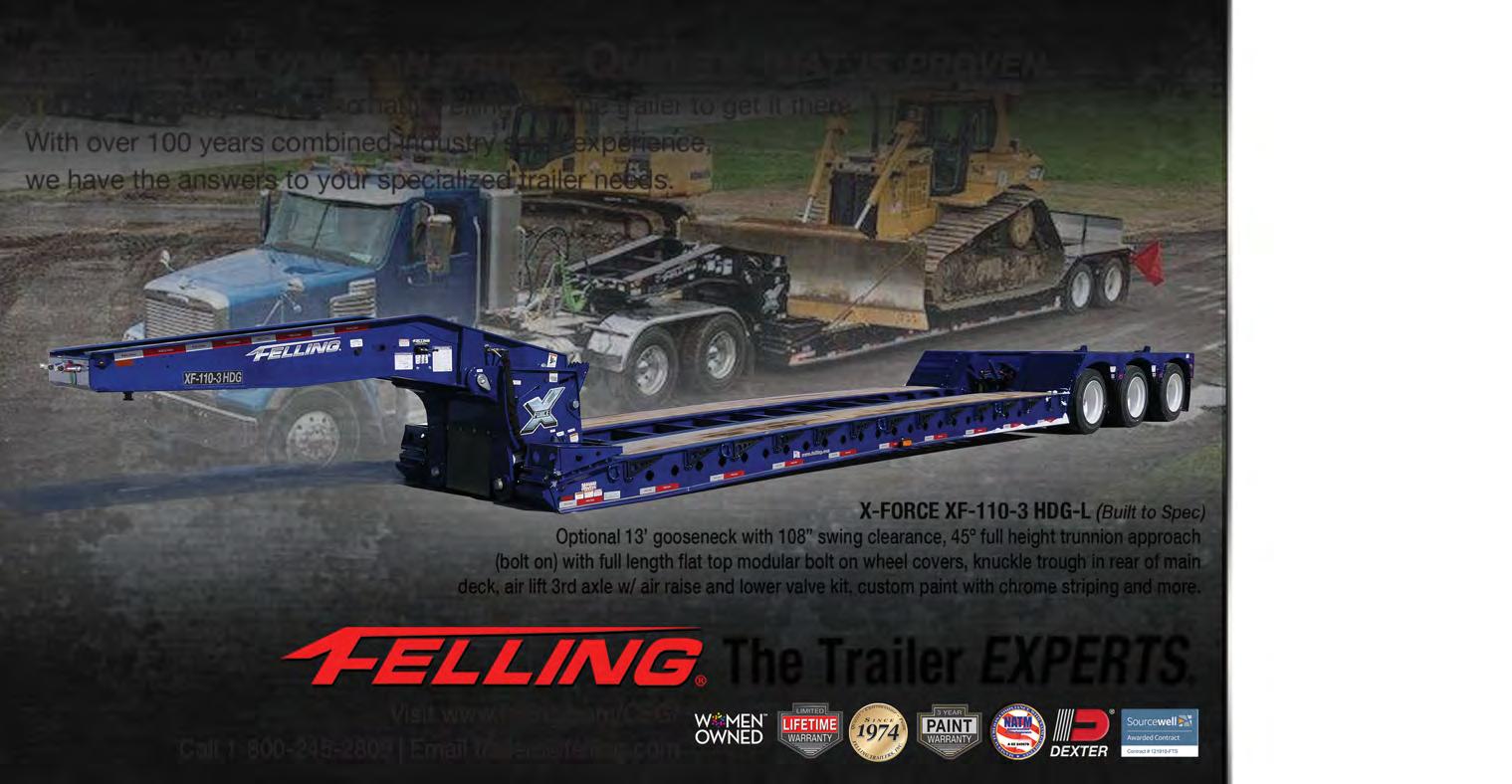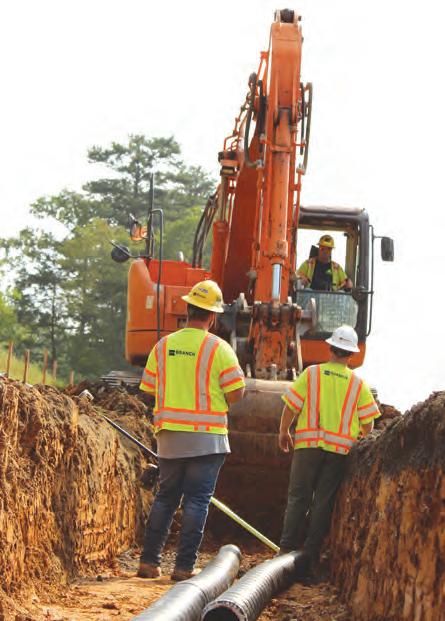
14 minute read
NAVISTAR NEXT Experience Trailer



Richmond Machinery
1701 Roseneath Road Richmond, VA 23230 804-359-4048 www.richmond machinery.com
East CEO, Co-Owner, Founder Howard Booher Passes Away
East Manufacturing Co. announced that its life-long chief executive, co-founder and co-owner, Howard D. Booher, passed away March 14 in his home in Randolph, Ohio, surrounded by his family.
Booher co-founded East in 1968 with Mark Tate and Robert Bruce; he was CEO for 54 years and co-owned the company alongside Bruce, who recently became CEO.
“Words cannot express the loss of our friend and colleague,” said Bruce. “Howard made an impact in the lives of not only his family but his employees, vendors and customers. We will miss his leadership and technical and engineering expertise. Our thoughts and prayers are with his family.”
“As a determined and passionate leader, Howard loved East and all its employees and customers with all his heart,” said Senior Vice President of Operations Gary Brown, a 42- year employee of East and friend of Booher. “A man of honesty and integrity, Howard was dedicated to his family and the company.” for the east Ohio area where it is still located today. And, according to Booher, the name East was “short and sweet.” Booher said, “we had tremendous road construction on the new interstate system that was centered in the area so it was the ideal location.”
Born and raised on a dairy farm, Booher’s hands-on experience as an aluminum welder led to his dream of building a better trailer with aluminum. Nearly 10 years ago, East reacquired its first dump trailer, which was welded by Booher and manufactured for its first customer, Tom Shields.
“The original East trailer has held up very well over its four decades of working life — living up to the lifetime ROI claims we make,” Booher said.
East Trailers
Booher was so very proud of East’s accomplishments with the aluminum dump trailer, including a truck dump body manufactured in 1970. While at the company, Booher designed its first sludge pusher trailer in 1978 and refuse transfer pusher trailer in 1980. As the company progressed, East brought the first aluminum flatbed, the BST, to market in 1982. The very next year, Booher was successful in building one of the first walking floor refuse transfer trailers in 1983.
By 1990, the first drop deck came on the scene followed by the MMX flatbed trailer in 2002.
In the dump and construction industry, East has become synonymous with the smoothsided East Genesis design, which Booher invented in 2001. Once the design caught on, most dump and many refuse trailers now boast the stronger, smooth-sided sidewalls, which are more aerodynamic, easier to clean and do not show dents from the inside.
East recently introduced its newest trailer, the horizon round bottom trailer. “It’s one of the most beautiful trailers we’ve ever built,” said Booher upon seeing the trailer’s first prototype.
Throughout his 54 years with East, Booher saw it through 20 expansions from its initial 7,200-sq.-ft. headquarters, built in 1968, to over 127 acres with 450,000-sq.-ft. of manufacturing and building space today. From its original 10 employees in 1968, under the Booher’s leadership East now employs more than 500 employees.
“Needless to say, we will all miss Howard so very much,” said Bruce. “Under his guidance, East has evolved from a small manufacturing company to one of the largest suppliers of aluminum trailers in North America.”
In 2016, Booher was an EY Entrepreneur of The Year 2016 Northeast Ohio finalist.
In addition to his dedication to his family and East, Booher also was owner of Mehrvale Farms and supported many local causes, including the Waterloo School Systems and the Randolph Fairgrounds.
In lieu of flowers, donations may be made to The Haven of Portage County at www.portagehaven.org.

Howard Booher

State DOTs Given Options for Using Current Bridge Inspection Intervals
RULES from page 36
FHWA noted that state departments of transportation inspect each and every bridge at least once every 24 months.
In addition to specialized training for bridge inspectors, the program also requires the collection of bridge condition data for inclusion in FHWA’s National Bridge Inventory, which helps transportation officials make informed decisions about funding priorities.
FHWA officially adopted the NBIS regulations in 1971 after the collapse of the Silver Bridge in West Virginia in 1967 due to a crack in the bridge’s suspension chain.
“That tragedy, which cost the lives of 46 people, brought national attention to the issue of bridge condition safety and led to a systematic effort to ensure oversight at the national level,” said AASHTO.
Good Timing
The updates come at a time when nearly 224,000 bridges across the country need repair. Some 43,600 are structurally deficient and in poor condition, according to ARTBA.
The number of bridges in need of repair represents 36 percent of all U.S. bridges, according to ARTBA’s latest bridge report, released early this year.
Some 48 percent of 619,588 bridges are in fair condition. But almost 80,000 bridges should be replaced, according to ARTBA.
“If placed end-to-end, these bridges would stretch over 6,100 miles — long enough to crisscross the country from Los Angeles to Portland, Maine, and back again,” said Alison Premo Black, the association’s chief economist.
Premo Black conducted the analysis for ARTBA.
The IIJA provides states with significant new resources to make long overdue infrastructure improvements, including bridge repairs, said ARTBA.
“The longer it takes to bridge the political divide on the FY 2022 spending bills, the longer it will take for transportation improvements to get started,” Dave Bauer, ARTBA president and CEO, said. “We urge Congress to act forthwith so that the American people can begin to realize the benefits of the historic investments in the bipartisan infrastructure law.”
Based on average repair and replacement cost data published by the FHWA and submitted by bridge owners (typically state DOTs), ARTBA estimates the cost of identified repairs for all 224,000 bridges, including the 43,578 structurally deficient, is $260 billion.
The number of structurally deficient bridges was down by 1,445 compared to 2020. At current pace, it would take 30 years to repair them all, said Premo Black.
Almost half of the 619,588 U.S. bridges — 48 percent — are rated in fair condition. “This means that the bridge shows evidence of minor deterioration or minor cracks,” said ARTBA.
The number of bridges in fair condition grew by 2,916 in 2021, reaching 297,888 structures.
At 4,504, Iowa leads the list of states with the largest number of bridges in poor condition. Pennsylvania with 3,198; Illinois, 2,405; Oklahoma, 2,296; Missouri, 2,218; New York, 1,672; Louisiana, 1,631; California, 1,493; West Virginia, 1,490 and Ohio, 1,334, follow.
States and territories with the most bridges in poor condition as a percentage of their total bridge inventory are West Virginia at 20 percent; Iowa, 19 percent; Rhode Island, 17.5 percent; South Dakota, 17.3 percent; Pennsylvania, 13.8 percent; Louisiana, 12.7 percent; Maine, 12.6 percent; Puerto Rico, 12.1 percent; North Dakota, 11.2 percent and Michigan, 11 percent.
Reliable Inspections
The rule addresses requirements set by MAP-21 offering states options in determining inspection intervals for bridges.
Each state can have the option to continue their current inspection intervals if they determine the requirement is satisfactory or choose to instate more rigorous requirements for inspectors.
This latter method would call for bridge specialists to assess potential risks to the point of failure for each individual bridge, or a cluster of bridges, to be further evaluated by experts, according to the organization Report Card for America’s Infrastructure.
“Current standards set inspection intervals at roughly 24 months apart with a maximum interval being 48 months. Bridges with higher risk considerations are inspected every 12 months.”
While the first method consists of similar regulations, it does differ by requiring more thorough criteria for establishing which bridges need 12-month intervals for inspections, said the organization.
The Federal Register notice says that the second method “involves the identification and use of an interval that is commensurate with the risk of safety of service loss in a given bridge.”
Inspectors could determine the risk factors based on what is described as an “impact and consequence matrix,” serving as a formula for assessing failure probability.
This matrix was based on research by a team of civil engineers that included Robert Connor of Purdue University and Glenn Washer of the University of Missouri.
“The results of the research will allow the intervals at which bridges are inspected to be established based on a risk-based approach,” Connor said. “It’s a compliment to see your work have a potentially major impact.”
The research followed initial work conducted for FHWA that developed risk-based inspection strategies for bridges that contain NSTM, or fracture critical members.
Connor said prior to the NBIS updates, bridge inspection standards were calendar-based, calling for on-site inspections every 24 months, regardless of the bridge’s age.
There were no explicit adjustments for age or circumstances such as environmental conditions that can wear on a bridge faster.
He said the research calls for a risk-based analysis that allows inspection efforts to focus on bridges and areas that are more likely to have problems or would have significant consequences should a problem arise.
“The research allows an owner to decide how to best manage the inspection needs of their diverse inventory of highway bridges,” said Connor, director of the Steel Bridge Research, Inspection, Training and Engineering Center. “Rather than over inspecting newer, healthy bridges, the interval can be rationally extended to, say, every 48 or 72 months for some.
“This will then allow an owner to spend more time on other bridges they are more concerned about and inspect those say every 12 months, for example.” CEG
6575 Blanding Blvd. Jacksonville, FL 32244 904-654-2602
4235 Murfreesboro Pike La Vergne, TN 37086 615-488-4068 www.equipmentshare.com

THE IRONPEDDLERS
3504 N. Rocky River Road Monroe, NC 28110 800-438-1933 704-289-8591
2820 Superior Drive Wake Forest (Raleigh), NC 27587 984-235-7665
209 E Victor Hill Road Duncan (Greenville), SC 29334 864-409-1143
3911 Wesley Street Myrtle Beach, SC 29579 843-236-2226 www.ironpeddlers.com
TRAXPLUS
9800 Highway 503 Hickory, MS 39332 601-635-5543 2891 S Frontage Road Columbus, MS 39701 662-368-3300 5122 Highway 98 Summit, MS 39666 601-600-7202 5913 Old Boyce Road Alexandria, MS 71308 318-542-7230 www.traxplus.com
PERRY BROTHERS EQUIPMENT COMPANY
523 US Hwy 280 E Americus, GA 31709 229-924-0035 843 Pinehurst-Hawkinsville Rd Pinehurst, GA 31070 229-273-4333 perryequip.com
Crews Construct 2,600 Ft. of Sound Walls Along New I-81 Corridor in Va.

Branch Civil photo
Workers on the project built the new lanes with 13 in. of No. 1 stone and 10 in. of No. 21 stone.
BRANCH from page 30
grass, which allowed them more flexibility in scheduling. The swales transformed ditches alongside the interstate into an environmentally friendly element designed to filter rainwater and return it to the water table in better condition than average. Most of the swales were about 5 ft. wide and 4 ft. deep, lined at the bottom with geotextile material to act as a sieve, keeping out unwanted material and allowing the rainwater to return to the groundwater cleaner.The team placed stone in the trench as well as compost and biomaterial to help with the filtration.
The team also built 2,600 ft. of sound walls to protect homeowners and businesses from the din of constant traffic.
Branch Civil used several large pieces of highway equipment to finish the job on time and budget. Examples include a Volvo 305 excavator, a Hitachi 290 excavator, a Cat 924 loader, Cat and Volvo 25-ton articulated dump trucks and Cat D3 and D6 dozers.
Sowers represents a small but growing trend of bringing more females into the construction industry, particularly within the professional ranks. The industry struggles to add workers, and adding women is an obvious step. According to the U.S. Department of Labor, just 9 percent of construction workers are women.
“The industry has treated me well,” said Sowers. “I would like to think that construction has come a long way in introducing women into what has been a predominantly male environment.”
“The men I have worked with have been extremely supportive,” she added. “I’ve never been singled out and treated differently because I am a woman. I believe my promotions and responsibility have been based on merit.”
Building a strong team is important to Sowers and management at Branch Civil.
“I’ve worked together with many different superintendents and foremen. I’ve found that the better team you can build, the better the work experience and the better the project results. I look at the project with a sense of pride in what we have accomplished. Sometimes, I go out of my way to drive on the road to re-experience what we did. It’s great to know that we have delivered an excellent project for our client and the public.” CEG

Branch Civil photo
Branch Civil crews relocate utilities on the I-81 project near Roanoke, Va.
Extending Global Reach... ConExpo-Con/AGG, IFPE Bring Success to Firms
ConExpo-Con/AGG, and the co-located International Fluid Power Exposition (IFPE), slated to return to Las Vegas March 14 to 18, 2023, have gained a reputation for bringing results to global attendees and exhibitors, and is working to expand that reputation for the 2023 show.
Considered one of the “Big 3” construction equipment trade shows globally, with the others held in Germany and France, ConExpoCon/AGG and IFPE is the largest construction trade show in the western hemisphere and is expected to bring in more than 130,000 attendees to see 2.7 million sq. ft. of exhibits at the Las Vegas Convention Center.
“For us, and coming from Spain, ConExpo-Con/AGG is the best platform to reach customers from the U.S. as well as from the world, especially from Central and South America,” said Jorge Cuartero, director general of ANMOPYC, the Spanish association of manufacturers of construction and mining equipment based in Zaragoza, Spain.
“The show features the latest equipment, products, services and technologies for the construction industry, as well as industry-leading education. And we know it will be the event of the year in our sector for 2023.”
One of the biggest values for international exhibitors and attendees is the International Trade Center, which offers attendees and exhibitors the opportunity to meet and network with industry peers from around the world. The International Trade Center is hosted by the Association of Equipment Manufacturers (AEM), co-owner of ConExpo-Con/AGG and IFPE.
“If you haven’t already, now is the time to start putting your ConExpo-Con/AGG and IFPE plans together,” said ConExpoCon/AGG Show Director Wuesthoff.
“Whether you are an exhibitor or attendee, start planning now. Knowing who from your team will get the most value out of coming, and what you hope to accomplish is the best way to make this show a positive investment in your company’s future.”
Machinery parts provider Blumaq, based in Vall de Uxó on Spain’s Mediterranean coast, said ConExpo-Con/AGG is an “unmissable event.”
“Blumaq’s participation in the 2020 show has resulted in an increase in visibility and sales for our brand,” said Juan Manuel Buils, marketing department manager at Blumaq. “We have exhibited before at ConExpo-Con/AGG, the best and largest showcase in the American heavy machinery and spare parts market, and as a result, we have generated a large number of leads and even closed sales at the fair itself.”
From Leicester, in the U.K.’s Midlands region, electrical and fabrication specialists Ventola Projects, Ltd. came away from the 2020 show with six figures in orders, and a huge jump in export business.
“We departed Las Vegas in 2020 with a confirmed order of $60,000, and further orders totaling more than $100,000 weeks later,” said Ventola Projects Managing Director Mick Ventola. “We have taken our exporting from approximately 40 percent of our turnover in 2019/20 to now almost 90 percent in 2021/22. Our forecasts show our turnover to continue an upward trend, even during these uncertain times.”
ConExpo-Con/AGG and IFPE 2020, hosted 130,000 in registered attendance, with 86 percent of attendees serving in decision-making roles.
“It is such a huge event, of people and organizations, acres of exhibits and dozens of mini events inside the venue. Even if you have a show plan built, if you are an international exhibitor or attendee, connect with the AEM-International Trade Centre team before, or on Day 1,” said Kim MacDonald of professional services firm 13 FACTORS, based in Halifax, Nova Scotia, Canada. “The centre became my go-to hub, and I am looking forward to using it even more in 2023.”
For more information, visit www.conexpoconagg.com.










